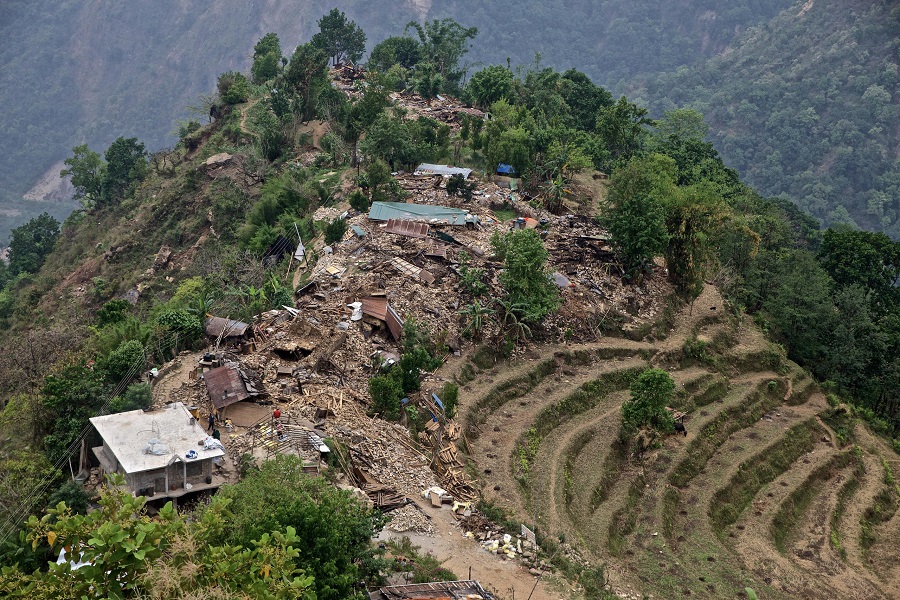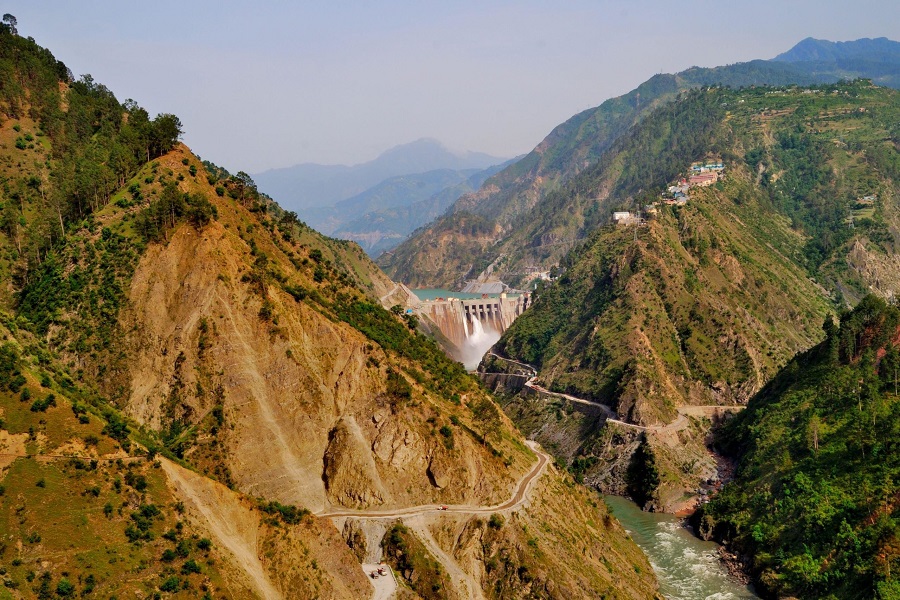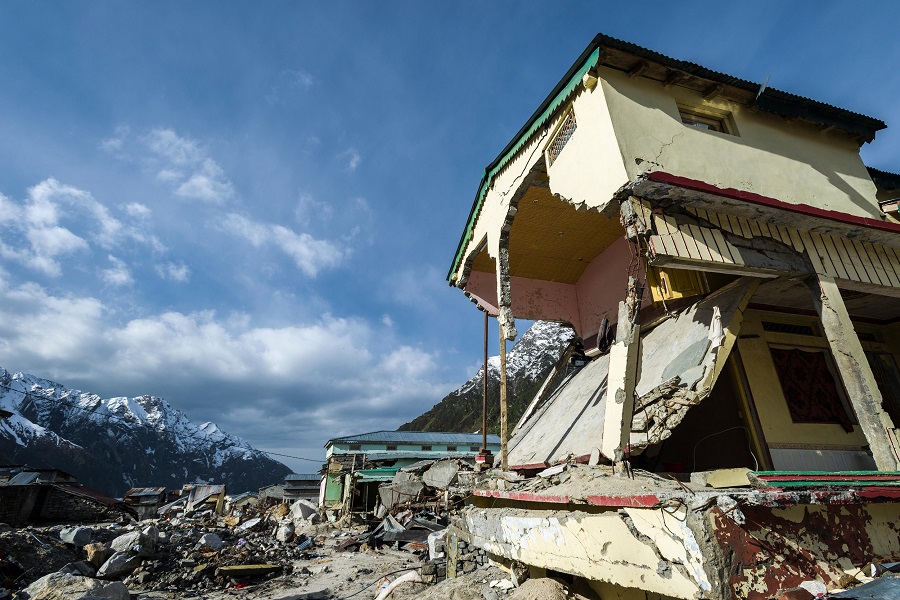Can climate change, hydropower project cause earthquakes in the Himalayas?
The Himalayas are relatively new mountains, created by the Indian tectonic plate being pushed under the Eurasian plate, causing it to buckle. Earthquakes are caused by a release of the pressure that builds when tectonic plates slip against each other, and so as this plate movement continues, the Himalayan region is very prone to earthquakes.
With climate change impacting weather patterns, melting glaciers and destabilising mountain slopes, it is already adding to the dangers associated with earthquakes in the Himalayas. Meanwhile, new research suggests that climate change may even be having an effect on the frequency of earthquakes in the region.
Are earthquakes becoming more frequent in the Himalayas?
An analysis of seismic activity in the Himalayas from 1900-2010 found a sharp uptick in the number of earthquakes recorded, particularly after 2000. According to the analysis, the Himalayas experienced fewer than 100 earthquakes per year in the decade 1960-70, but between 2000 and 2010 this had increased to 500-600. The vast majority of these earthquakes were between 2.0 and 6.0 on the Richter scale, ranging in magnitude from tremors that are just about detectable with good equipment to earthquakes that could be felt by anyone and would damage badly built structures (though with zero to light damage to properly built structures). However, the analysis did not draw a link between this rise and climate change.
Can climate change cause earthquakes in the Himalayas?
The Himalayas host some 100,000 km2 of glaciers, making the region the largest ice reserve on Earth outside the two poles. The Himalayas are also warming faster than the global average – in 2022 the Intergovernmental Panel on Climate Change estimates that under a scenario of moderate carbon emissions, Himalayan glaciers would lose 10-30% of their mass by 2030.
This change in glacial mass in the Himalayas could trigger more earthquakes thanks to a process called isostasy, according to Mudassir Bhat, an earth scientist at the University of Kashmir. Isostasy describes how the Earth’s crust rises and settles based on the weight it bears; the impacts of glaciers on this process is known as glacial isostatic adjustment (GIA). Since the Himalayan region is crossed by several major faults, Bhat believes that the movement in the earth’s crust caused by loss of glacial mass via GIA could trigger more earthquakes. This process has been demonstrated in other regions.
But glaciers are not the only thing that puts pressure on the Earth’s crust in the Himalayas. The monsoon, which provides South Asia with nearly 80% of its annual precipitation in just four months (from June to September), also plays a role.
Research by French and Nepalese scientists into seasonal patterns in 10,000 earthquakes in the Nepal Himalayas concluded that “the seismicity rate [number of earthquakes] in the winter is twice as high as in the summer at all magnitudes above the detection threshold.” They attributed this to pressure placed on the Gangetic basin by the huge weight of water present during the monsoon season suppressing seismicity.
According to Zahid Rafi, chief seismologist and director of Pakistan’s National Seismic Monitoring Centre in Islamabad, “The correlation [with more earthquakes in the winter] is in micro-seismicity – tiny earthquakes with relatively lesser magnitudes that occur quite frequently.” Nonetheless, he said these small earthquakes could “potentially be a contributor to triggering a damaging earthquake”.

Destruction in Madre village, Nepal, after a major earthquake in May 2015 (Image: Majority World CIC /Alamy)
As climate change makes the monsoon more erratic, changing when and where large quantities of water are present on the Indian subcontinent, this could have an impact on this micro-seismicity, with longer drier periods meaning more activity. While most of these tiny earthquakes will not be felt by humans, much less cause any damage, the bigger question is whether smaller earthquakes relieve stress, making larger destructive earthquakes above 6 on the Richter scale less likely, or whether a build-up of small earthquakes may trigger a larger one.
In a 2019 interview, Paul Lundgren of NASA’s Jet Propulsion Laboratory in Pasadena, California, addressed this very question. “We don’t know when a fault may be at the critical point where a non-tectonic forcing related to a climate process [when a fault in the plates is at such a delicate stage that a climate impact could set it off] could be the straw that breaks the camel’s back, resulting in a sizeable earthquake… We’re simply not in a position at this point to say that climate processes could trigger a large quake.”
Can large infrastructure construction trigger earthquakes?
Earthquakes can be induced by human activity, and this has been documented since the 1960s in the case of hydropower dams, due to the effects of large reservoirs and what is called reservoir-induced seismicity (RIS). This refers to the pressure created by water in a large reservoir on or near a fault line leading to slippage of the Earth’s crust underneath, causing an earthquake.
There are currently about 100 operational hydropower dams across the Himalayan region, with an additional 650 planned or under construction, including in China, India, Pakistan, Nepal, and Bhutan. If all these projects are completed, the Himalayas will become the most dam-dense region in the world, especially in particular areas such as the Chenab region in Jammu and along the Brahmaputra in Arunachal Pradesh.

The Baglihar hydroelectric project on the Chenab River, in Jammu. If all currently planned projects are built, this will become one of the most dam-dense areas in the world. (Image: Sharvari Mehendale / Alamy)
According to Ayaz Mahmood Dar, an integrated researcher of earth sciences and director of Tehkeek International, a research institute based in Srinagar, Jammu and Kashmir, “The Chenab valley [in Jammu] is a case study of reservoir-induced seismicity.” In addition to four existing mega hydroelectric power projects in the Chenab valley, at least six other mega projects are currently in various stages of development.
In August 2022, 13 earthquakes struck the valley in less than five days. “The valley rests on the Kishtwar Fault, and it’s apparent that the construction of mega dams is the main reason behind the increased seismicity in the region. However, more research needs to be put in to get a holistic picture,” Dar says.
How does climate change make earthquakes more dangerous?
The destructive impact of major earthquakes can become magnified in what is called a ‘complex disaster’ – one in which one disaster, such as an earthquake, sets off another, such as a landslide or glacial lake outburst flood (GLOF).
A GLOF occurs when a lake formed by meltwater from a glacier breaches its banks. Glacial lakes are rarely stable, and when a GLOF occurs, the debris that held the water back is often carried by the outburst, with potential for massive damage. Globally, over 15 million people are at risk of GLOFs, with a third of all those at risk located in India (3 million) and Pakistan (2 million).
Rakesh Kayastha, a seismologist working at the Himalayan Cryosphere, Climate and Disaster Research Center at Kathmandu University, Nepal, tells The Third Pole that an earthquake in the Himalayas that measures above 5 on the Richter scale carries a heightened danger compared to an earthquake of similar magnitude elsewhere, because it may also trigger a GLOF.

Buildings in Nagar Panchayat, Uttarakhand, damaged by a flood in 2013, when heavy rains and an avalanche caused the Chorabari glacial lake to burst its banks (Image: Frank Bienewald / Alamy)
Rising temperatures driven by climate change are causing Himalayan glaciers to melt at an increasing rate, creating more and more glacial lakes in the process. Researchers have identified more than 8,000 glacial lakes in the Himalayas, of which up to 200 may be potentially dangerous. Between 2003 and 2010, 85 new glacial lakes formed in the Indian Himalayan state of Sikkim alone. Dark pollutants from sources like open burning and coal plants in lowland areas also settle on glaciers in the Himalayas, causing them to absorb more energy and thereby accelerating glacial melt, exacerbating the impacts of temperature rise.
Another way in which climate change-induced warming could trigger earthquakes in the Himalayas is that when a large section of a melting glacier breaks off and falls, this can lead to cryo-seismicity – or an ‘icequake’, a seismic event caused by breaks in ice or ice-saturated ground, as seen in the polar regions. “The breakage of glaciers can trigger cryo-seismicity [measuring] up to 7 on the Richter scale,” says Ayaz Mahmood Dar. “This threat is real in the Himalayas because with glaciers absorbing more heat, the possibility of cracks and therefore, icequakes, is more than ever.”
Increasing complex disasters in the Himalayas
So far, the breakage of glaciers has not led to large cryo-seismic events in the Himalayas. What has been observed is complex disasters, with breaking glaciers leading to floods and landslides. In February 2021, this is exactly what happened, when a large chunk of a glacier broke off in the Indian state of Uttarakhand, triggered by an avalanche rather than an earthquake, setting off a flash flood and damaging an under-construction dam.
Climate change is making complex disasters more likely in the Himalayas. For example, with less predictable monsoons, and more concentrated rainfall, landslides across the Himalayan region are increasing. In 2020, a NASA research team estimated that the Nepal-China border region will experience 30-70% more landslides by 2061-2100. This area houses many glaciers and glacial lakes, meaning that there is a heightened chance of landslides triggering GLOFs, and vice versa. Furthermore, there is now clear evidence that climate change is increasing slope instability in high mountain areas, meaning they are more prone to rockfalls and landslides.
In the case of a large earthquake, all of these elements could – in a worst-case scenario – combine together. Such complex disasters would cause massive damage, while also complicating and limiting relief efforts.
“The issues of landslides along the Himalayas are of serious nature as observed from the experience of the Kashmir earthquake in 2005 [which triggered landslides, and led to the deaths of more than 86,000 people]. The relief efforts carried out for the survivors were hampered by the landslides, falling rocks, and numerous aftershock activities, which damaged highways and mountain roads and made the affected areas inaccessible for several weeks,” said Zahid Rafi of Pakistan’s National Seismic Monitoring Centre.
Additional inputs by Omair Ahmad
This article originally appeared on The Third Pole. Read the original article here.

